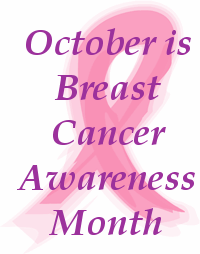A lesser-known campaign that took place last week was National Nuclear Science Week. This is a nationally observed week-long celebration to focus on local, regional, and national interest on all aspects of nuclear science. Therefore, in honor of both campaigns I wanted to devote this blog to both nuclear medicine and breast cancer.
Nuclear medicine involves the use of radioisotopes for the diagnosis or treatment of disease. A radioisotope is an atom that has an excess amount of mass. To get rid of this mass the atom emits one or more particles. Unlike radon in basements or potassium in bananas, radioisotopes used for medicine do not occur naturally on earth. They are produced by colliding high-speed particles from nuclear reactors or particle accelerators with targets, and the radioactive material in the target can be isolated and used for medicine.
For most procedures a radioactive isotope is combined to a drug that can map out a certain function in the body. For example, fludeoxyglucose (yes a mouthful) or FDG is labeled with the radioisotope fluorine-19 to provide an image of metabolism inside a patient's body. Metabolism is a process used by cells to create energy. It turns out that cancerous cells often need more energy than healthy cells to sustain growth, so they are more metabolic. Therefore, when injected into a cancer patient radiolabeled FDG will predominantly seek out cancerous cells. By placing a patient in a PET scanner (a really fancy camera) a physician can take pictures of the location of the FDG in the body. This type of technique is used to diagnose a variety of cancers in the patient including breast cancer.
Another very common procedure for breast cancer that uses radioactive material is the sentinel node biopsy. The sentinel node is the lymph node located closest to the tumor and is the first pit stop for cancer cells if or when they escape the tumor. During the biopsy it is difficult to find the sentinel node because it is in close proximity to other lymph nodes. To help surgeons find the correct node a small amount of radioactive material, called technetium-99m, is often injected near the tumor prior to surgery. Just like cancer cells, the first stop for technetium once injected is the sentinel node. During surgery the surgeon uses a small probe (think metal detector for radioactive material) to locate the region where the concentration of radioactive material is the highest, which should correspond to the sentinel node.
Radioisotopes are also used to guide breast cancer lumpectomies. Depending on the type and stage of the tumor, many patients will elect to have a lumpectomy. A lumpectomy is the surgical procedure of removing the tumor from the breast of a cancer patient. For many of these cases a tiny radioactive seed is implanted into the patient using a catheter or needle prior to the operation. The seed, which is smaller than grain of rice, consists of the radioisotope iodine-125 that is encapsulated in titanium. During the surgery, the surgeon uses a small probe (yes, the same one as before) to locate the seed in order to guide each incision as they work their way to the tumor.
In addition to mammography and radiation therapy, nuclear medicine is yet another example of how technology that utilizes ionizing radiation has made a significant impact in the battle against breast cancer. I have provided three examples in this blog entry, but there are many more. In addition, exciting new research projects are underway exploring novel uses of radioisotopes to treat breast cancer (check out this project involving one of my collaborators). We have a long way to go before this disease is eradicated, but thanks to nuclear medicine we have made tremendous strides extending survival and improving the quality of life of breast cancer patients.
 Turn on a football game this Sunday and you will see very large men in pads slamming into their opponents wearing pink shoes, socks, gloves, and other brightly colored pink garb. A somewhat ironic yet symbolic gesture by the National Football League, one that not only reminds fans that it is Breast Cancer Awareness month, but also reflects the mental and physical toughness of every single breast cancer patient or survivor and their families that have to deal with this frightening disease. As I pointed out in my last blog post on this issue, we have come a long way in terms of diagnosis and treatment, and medical procedures that utilize ionizing radiation deserve much of the praise. However, there is still much that can be done, since more than 230,000 new cases of breast cancer will be diagnosed in 2015 alone.
Turn on a football game this Sunday and you will see very large men in pads slamming into their opponents wearing pink shoes, socks, gloves, and other brightly colored pink garb. A somewhat ironic yet symbolic gesture by the National Football League, one that not only reminds fans that it is Breast Cancer Awareness month, but also reflects the mental and physical toughness of every single breast cancer patient or survivor and their families that have to deal with this frightening disease. As I pointed out in my last blog post on this issue, we have come a long way in terms of diagnosis and treatment, and medical procedures that utilize ionizing radiation deserve much of the praise. However, there is still much that can be done, since more than 230,000 new cases of breast cancer will be diagnosed in 2015 alone.
